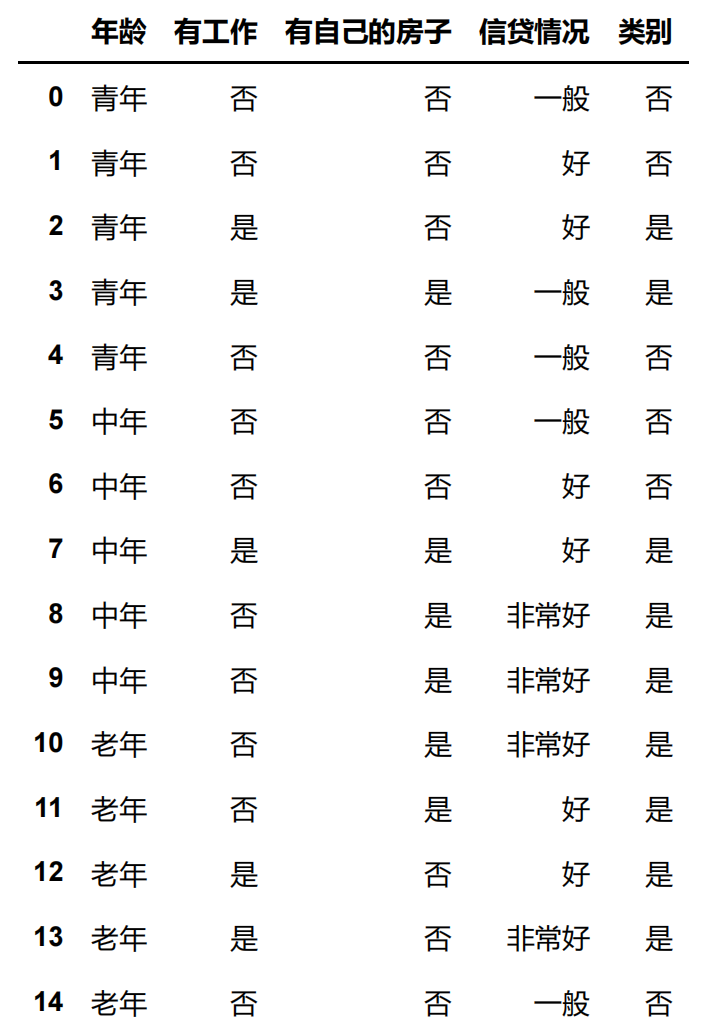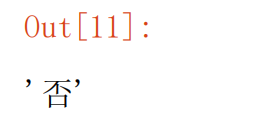机器学习 实验四
| 博客班级 | https://edu.cnblogs.com/campus/ahgc/machinelearning/ |
|---|---|
| 作业要求 | https://edu.cnblogs.com/campus/ahgc/machinelearning/homework/12086 |
| 作业目标 | 理解决策树算法原理,掌握决策树算法框架 |
| 学号 | 3180701239 |
| 【实验目的】 | |
| 1.理解决策树算法原理,掌握决策树算法框架; | |
| 2.理解决策树学习算法的特征选择、树的生成和树的剪枝; | |
| 3.能根据不同的数据类型,选择不同的决策树算法; | |
| 4.针对特定应用场景及数据,能应用决策树算法解决实际问题。 | |
| 【实验内容】 | |
| 1.设计算法实现熵、经验条件熵、信息增益等方法。 | |
| 2.实现ID3算法。 | |
| 3.熟悉sklearn库中的决策树算法; | |
| 4.针对iris数据集,应用sklearn的决策树算法进行类别预测。 | |
| 5.针对iris数据集,利用自编决策树算法进行类别预测。 | |
| 【实验报告要求】 | |
| 1.对照实验内容,撰写实验过程、算法及测试结果; | |
| 2.代码规范化:命名规则、注释; | |
| 3.分析核心算法的复杂度; | |
| 4.查阅文献,讨论ID3、5算法的应用场景; | |
| 【实验过程】 | |
| In[1]: | |
| import numpy as np | |
| import pandas as pd | |
| import matplotlib.pyplot as plt | |
| %matplotlib inline | |
| from sklearn.datasets import load_iris | |
| from sklearn.model_selection import train_test_split | |
| from collections import Counter | |
| import math | |
| from math import log | |
| import pprint | |
| In[2]: | |
| def create_data(): | |
| datasets = [['青年', '否', '否', '一般', '否'], | |
| ['青年', '否', '否', '好', '否'], | |
| ['青年', '是', '否', '好', '是'], | |
| ['青年', '是', '是', '一般', '是'], | |
| ['青年', '否', '否', '一般', '否'], | |
| ['中年', '否', '否', '一般', '否'], | |
| ['中年', '否', '否', '好', '否'], | |
| ['中年', '是', '是', '好', '是'], | |
| ['中年', '否', '是', '非常好', '是'], | |
| ['中年', '否', '是', '非常好', '是'], | |
| ['老年', '否', '是', '非常好', '是'], | |
| ['老年', '否', '是', '好', '是'], | |
| ['老年', '是', '否', '好', '是'], | |
| ['老年', '是', '否', '非常好', '是'], | |
| ['老年', '否', '否', '一般', '否'], | |
| ] | |
| labels = [u'年龄', u'有工作', u'有自己的房子', u'信贷情况', u'类别'] | |
| # 返回数据集和每个维度的名称 | |
| return datasets, labels | |
| In[3]: | |
| datasets, labels = create_data() | |
| In[4]: | |
| train_data = pd.DataFrame(datasets, columns=labels) | |
| In[5]: | |
| train_data | |
| Out[5]: | |
 |
|
| In[6]: |
熵
def calc_ent(datasets):
data_length = len(datasets)
label_count = {}
for i in range(data_length):
label = datasets[i][-1]
if label not in label_count:
label_count[label] = 0
label_count[label] += 1
ent = -sum([(p / data_length) * log(p / data_length, 2)
for p in label_count.values()])
return ent
def entropy(y):
"""
Entropy of a label sequence
"""
hist = np.bincount(y)
ps = hist / np.sum(hist)
return -np.sum([p * np.log2(p) for p in ps if p > 0])
经验条件熵
def cond_ent(datasets, axis=0):
data_length = len(datasets)
feature_sets = {}
for i in range(data_length):
feature = datasets[i][axis]
if feature not in feature_sets:
feature_sets[feature] = []
feature_sets[feature].append(datasets[i])
cond_ent = sum(
[(len(p) / data_length) * calc_ent(p) for p in feature_sets.values()])
return cond_ent
信息增益
def info_gain(ent, cond_ent):
return ent - cond_ent
def info_gain_train(datasets):
count = len(datasets[0]) - 1
ent = calc_ent(datasets)
# ent = entropy(datasets)
best_feature = []
for c in range(count):
c_info_gain = info_gain(ent, cond_ent(datasets, axis=c))
best_feature.append((c, c_info_gain))
print('特征({}) - info_gain - {:.3f}'.format(labels[c], c_info_gain))
# 比较大小
best_ = max(best_feature, key=lambda x: x[-1])
return '特征({})的信息增益最大,选择为根节点特征'.format(labels[best_[0]])
In[7]:
info_gain_train(np.array(datasets))
Out[7]:

In[8]:
定义节点类 二叉树
class Node:
def init(self, root=True, label=None, feature_name=None, feature=None):
self.root = root
self.label = label
self.feature_name = feature_name
self.feature = feature
self.tree = {}
self.result = {
'label:': self.label,
'feature': self.feature,
'tree': self.tree
}
def __repr__(self):
return '{}'.format(self.result)
def add_node(self, val, node):
self.tree[val] = node
def predict(self, features):
if self.root is True:
return self.label
return self.tree[features[self.feature]].predict(features)
class DTree:
def init(self, epsilon=0.1):
self.epsilon = epsilon
self._tree = {}
# 熵
@staticmethod
def calc_ent(datasets):
data_length = len(datasets)
label_count = {}
for i in range(data_length):
label = datasets[i][-1]
if label not in label_count:
label_count[label] = 0
label_count[label] += 1
ent = -sum([(p / data_length) * log(p / data_length, 2)
for p in label_count.values()])
return ent
# 经验条件熵
def cond_ent(self, datasets, axis=0):
data_length = len(datasets)
feature_sets = {}
for i in range(data_length):
feature = datasets[i][axis]
if feature not in feature_sets:
feature_sets[feature] = []
feature_sets[feature].append(datasets[i])
cond_ent = sum([(len(p) / data_length) * self.calc_ent(p)
for p in feature_sets.values()])
return cond_ent
# 信息增益
@staticmethod
def info_gain(ent, cond_ent):
return ent - cond_ent
def info_gain_train(self, datasets):
count = len(datasets[0]) - 1
ent = self.calc_ent(datasets)
best_feature = []
for c in range(count):
c_info_gain = self.info_gain(ent, self.cond_ent(datasets, axis=c))
best_feature.append((c, c_info_gain))
# 比较大小
best_ = max(best_feature, key=lambda x: x[-1])
return best_
def train(self, train_data):
"""
input:数据集D(DataFrame格式),特征集A,阈值eta
output:决策树T
"""
_, y_train, features = train_data.iloc[:, :
-1], train_data.iloc[:,
-1], train_data.columns[:
-1]
# 1,若D中实例属于同一类Ck,则T为单节点树,并将类Ck作为结点的类标记,返回T
if len(y_train.value_counts()) == 1:
return Node(root=True, label=y_train.iloc[0])
# 2, 若A为空,则T为单节点树,将D中实例树最大的类Ck作为该节点的类标记,返回T
if len(features) == 0:
return Node(
root=True,
label=y_train.value_counts().sort_values(
ascending=False).index[0])
# 3,计算最大信息增益 同5.1,Ag为信息增益最大的特征
max_feature, max_info_gain = self.info_gain_train(np.array(train_data))
max_feature_name = features[max_feature]
# 4,Ag的信息增益小于阈值eta,则置T为单节点树,并将D中是实例数最大的类Ck作为该节点的类标记,返
if max_info_gain < self.epsilon:
return Node(
root=True,
label=y_train.value_counts().sort_values(
ascending=False).index[0])
# 5,构建Ag子集
node_tree = Node(
root=False, feature_name=max_feature_name, feature=max_feature)
feature_list = train_data[max_feature_name].value_counts().index
for f in feature_list:
sub_train_df = train_data.loc[train_data[max_feature_name] ==
f].drop([max_feature_name], axis=1)
# 6, 递归生成树
sub_tree = self.train(sub_train_df)
node_tree.add_node(f, sub_tree)
# pprint.pprint(node_tree.tree)
return node_tree
def fit(self, train_data):
self._tree = self.train(train_data)
return self._tree
def predict(self, X_test):
return self._tree.predict(X_test)
In[9]:
datasets, labels = create_data()
data_df = pd.DataFrame(datasets, columns=labels)
dt = DTree()
tree = dt.fit(data_df)
In[10]:
tree
Out[10]:

In[11]:
dt.predict(['老年', '否', '否', '一般'])
Out[11]:

In[12]:
data
def create_data():
iris = load_iris()
df = pd.DataFrame(iris.data, columns=iris.feature_names)
df['label'] = iris.target
df.columns = [
'sepal length', 'sepal width', 'petal length', 'petal width', 'label'
]
data = np.array(df.iloc[:100, [0, 1, -1]])
# print(data)
return data[:, :2], data[:, -1]
X, y = create_data()
X_train, X_test, y_train, y_test = train_test_split(X, y, test_size=0.3)
In[13]:
from sklearn.tree import DecisionTreeClassifier
from sklearn.tree import export_graphviz
import graphviz
In[14]:
clf = DecisionTreeClassifier()
clf.fit(X_train, y_train,)
Out[14]:

In[15]:
clf.score(X_test, y_test)
Out[15]:

In[16]:
tree_pic = export_graphviz(clf, out_file="mytree.pdf")
with open('mytree.pdf') as f:
dot_graph = f.read()
In[17]:
graphviz.Source(dot_graph)
Out[17]:


In[18]:
from sklearn.tree import DecisionTreeClassifier
from sklearn import preprocessing
import numpy as np
import pandas as pd
from sklearn import tree
import graphviz
features = ["年龄", "有工作", "有自己的房子", "信贷情况"]
X_train = pd.DataFrame([
["青年", "否", "否", "一般"],
["青年", "否", "否", "好"],
["青年", "是", "否", "好"],
["青年", "是", "是", "一般"],
["青年", "否", "否", "一般"],
["中年", "否", "否", "一般"],
["中年", "否", "否", "好"],
["中年", "是", "是", "好"],
["中年", "否", "是", "非常好"],
["中年", "否", "是", "非常好"],
["老年", "否", "是", "非常好"],
["老年", "否", "是", "好"],
["老年", "是", "否", "好"],
["老年", "是", "否", "非常好"],
["老年", "否", "否", "一般"]
])
y_train = pd.DataFrame(["否", "否", "是", "是", "否",
"否", "否", "是", "是", "是",
"是", "是", "是", "是", "否"])
数据预处理
le_x = preprocessing.LabelEncoder()
le_x.fit(np.unique(X_train))
X_train = X_train.apply(le_x.transform)
le_y = preprocessing.LabelEncoder()
le_y.fit(np.unique(y_train))
y_train = y_train.apply(le_y.transform)
调用sklearn.DT建立训练模型
model_tree = DecisionTreeClassifier()
model_tree.fit(X_train, y_train)
可视化
dot_data = tree.export_graphviz(model_tree, out_file=None,
feature_names=features,
class_names=[str(k) for k in np.unique(y_train)],
filled=True, rounded=True,
special_characters=True)
graph = graphviz.Source(dot_data)
graph
Out[18]:

In[19]:
import numpy as np
class LeastSqRTree:
def init(self, train_X, y, epsilon):
# 训练集特征值
self.x = train_X
# 类别
self.y = y
# 特征总数
self.feature_count = train_X.shape[1]
# 损失阈值
self.epsilon = epsilon
# 回归树
self.tree = None
def _fit(self, x, y, feature_count, epsilon):
# 选择最优切分点变量j与切分点s
(j, s, minval, c1, c2) = self._divide(x, y, feature_count)
# 初始化树
tree = {"feature": j, "value": x[s, j], "left": None, "right": None}
if minval < self.epsilon or len(y[np.where(x[:, j] <= x[s, j])]) <= 1:
tree["left"] = c1
else:
tree["left"] = self._fit(x[np.where(x[:, j] <= x[s, j])],
y[np.where(x[:, j] <= x[s, j])],
self.feature_count, self.epsilon)
if minval < self.epsilon or len(y[np.where(x[:, j] > s)]) <= 1:
tree["right"] = c2
else:
tree["right"] = self._fit(x[np.where(x[:, j] > x[s, j])],
y[np.where(x[:, j] > x[s, j])],
self.feature_count, self.epsilon)
return tree
def fit(self):
self.tree = self._fit(self.x, self.y, self.feature_count, self.epsilon)
@staticmethod
def _divide(x, y, feature_count):
# 初始化损失误差
cost = np.zeros((feature_count, len(x)))
# 公式5.21
for i in range(feature_count):
for k in range(len(x)):
# k行i列的特征值
value = x[k, i]
y1 = y[np.where(x[:, i] <= value)]
c1 = np.mean(y1)
y2 = y[np.where(x[:, i] > value)]
c2 = np.mean(y2)
y1[:] = y1[:] - c1
y2[:] = y2[:] - c2
cost[i, k] = np.sum(y1 * y1) + np.sum(y2 * y2)
# 选取最优损失误差点
cost_index = np.where(cost == np.min(cost))
# 选取第几个特征值
j = cost_index[0][0]
# 选取特征值的切分点
s = cost_index[1][0]
# 求两个区域的均值c1,c2
c1 = np.mean(y[np.where(x[:, j] <= x[s, j])])
c2 = np.mean(y[np.where(x[:, j] > x[s, j])])
return j, s, cost[cost_index], c1, c2
In[20]:
train_X = np.array([[1, 2, 3, 4, 5, 6, 7, 8, 9, 10]]).T y = np.array([4.50, 4.75, 4.91, 5.34, 5.80, 7.05, 7.90, 8.23, 8.70, 9.00])
model_tree = LeastSqRTree(train_X, y, .2)
model_tree.fit()
model_tree.tree


Out[20]:




 浙公网安备 33010602011771号
浙公网安备 33010602011771号